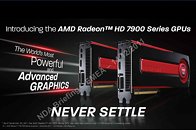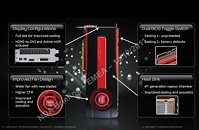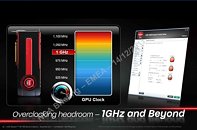- Joined
- Oct 9, 2007
- Messages
- 47,527 (7.48/day)
- Location
- Hyderabad, India
| System Name | RBMK-1000 |
|---|---|
| Processor | AMD Ryzen 7 5700G |
| Motherboard | ASUS ROG Strix B450-E Gaming |
| Cooling | DeepCool Gammax L240 V2 |
| Memory | 2x 8GB G.Skill Sniper X |
| Video Card(s) | Palit GeForce RTX 2080 SUPER GameRock |
| Storage | Western Digital Black NVMe 512GB |
| Display(s) | BenQ 1440p 60 Hz 27-inch |
| Case | Corsair Carbide 100R |
| Audio Device(s) | ASUS SupremeFX S1220A |
| Power Supply | Cooler Master MWE Gold 650W |
| Mouse | ASUS ROG Strix Impact |
| Keyboard | Gamdias Hermes E2 |
| Software | Windows 11 Pro |
AMD Radeon HD 7970 launch is just around the corner. Ahead of its launch, AMD conducted its usual press briefing. DonanimHaber has access to some of the slides shown in that meeting. Earlier this day, we brought you perhaps the most important of them all, specifications. Let's take a look at the reference board design itself. AMD is sticking to the black+red colour scheme, and has come up with a swanky new cooling assembly design. The design, unlike those of higher-end Radeon HD 6000 series graphics cards, is surprisingly curvy and features dashes of red plastic making up its contours, surrounded by tougher black ABS.
A welcome change here from the previous generations, is that the card is truly single-slot capable, when say, a single-slot full-coverage water block is used. High-end cards from previous generation HD 5000 and HD 6000 have a dual DVI connector cluster that extends into two expansion slots, which many enthusiasts found to be annoying, especially when setting up benches with four single-GPU graphics cards in scenarios where PCI-Express slot spacing isn't kind. Moving on to display connectivity, the card has one DVI, one HDMI, and two mini-DisplayPort connectors, all arranged in the confines of a single expansion slot. The space of the second slot is dedicated to a hot-air exhaust of the cooling assembly. All board partners are required to ship HDMI-to-DVI dongles, and active mini-DP dongles.



The cooler uses a full-coverage vapor-chamber plate to collect heat from all major components on the obverse side of the card, and convey it to the aluminum fin channel array attached to it. These components include the 4.3 billion transistor Tahiti GPU, 12 GDDR5 memory chips, and MOSFETs found across the various V-reg areas of the card. The aluminum fin channel array is ventilated by a blower. AMD claims to have improved the blower design from previous generations to have higher air-flow and improved acoustics.
Like with the HD 6900 series, the HD 7900 series reference boards feature two sets of BIOS, located in two separate EEPROM chips that can be toggled using a small switch on the top of the card (next to the CFBI connectors). The 1st EEPROM is "unprotected", it packs reference speeds, but you can flash it with your own modified BIOS. The second EEPROM is "protected" from flashes, and packs failsafe reference speeds. It's your insurance against BIOS flashing screw-ups, and cuts down the cumbersome process of BIOS recovery using a second display card, or the rocket-science of "blind-flashing".
Lastly, AMD talks about overclocking headroom. The HD 7970 looks to have default core speed of "a little over 900 MHz", could be 925 MHz for all we know, looking at that last slide. AMD says that overclocking to 1 GHz core is well within reach using the reference cooler, "and beyond".
View at TechPowerUp Main Site
A welcome change here from the previous generations, is that the card is truly single-slot capable, when say, a single-slot full-coverage water block is used. High-end cards from previous generation HD 5000 and HD 6000 have a dual DVI connector cluster that extends into two expansion slots, which many enthusiasts found to be annoying, especially when setting up benches with four single-GPU graphics cards in scenarios where PCI-Express slot spacing isn't kind. Moving on to display connectivity, the card has one DVI, one HDMI, and two mini-DisplayPort connectors, all arranged in the confines of a single expansion slot. The space of the second slot is dedicated to a hot-air exhaust of the cooling assembly. All board partners are required to ship HDMI-to-DVI dongles, and active mini-DP dongles.



The cooler uses a full-coverage vapor-chamber plate to collect heat from all major components on the obverse side of the card, and convey it to the aluminum fin channel array attached to it. These components include the 4.3 billion transistor Tahiti GPU, 12 GDDR5 memory chips, and MOSFETs found across the various V-reg areas of the card. The aluminum fin channel array is ventilated by a blower. AMD claims to have improved the blower design from previous generations to have higher air-flow and improved acoustics.
Like with the HD 6900 series, the HD 7900 series reference boards feature two sets of BIOS, located in two separate EEPROM chips that can be toggled using a small switch on the top of the card (next to the CFBI connectors). The 1st EEPROM is "unprotected", it packs reference speeds, but you can flash it with your own modified BIOS. The second EEPROM is "protected" from flashes, and packs failsafe reference speeds. It's your insurance against BIOS flashing screw-ups, and cuts down the cumbersome process of BIOS recovery using a second display card, or the rocket-science of "blind-flashing".
Lastly, AMD talks about overclocking headroom. The HD 7970 looks to have default core speed of "a little over 900 MHz", could be 925 MHz for all we know, looking at that last slide. AMD says that overclocking to 1 GHz core is well within reach using the reference cooler, "and beyond".
View at TechPowerUp Main Site









 PPP
PPP




 just might be time for an upgrade
just might be time for an upgrade